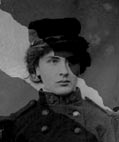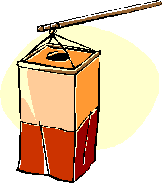I guess it would be interesting to reproduce here some of
the tricks used by the earlier photographers. It is funny to notice that
many technical issues we are facing today...
were already existing in 1900.
Need one example ? Protect a photo against the counterfeiting.
 |
e
CAUTION f
Photographers in 1900 were artists but also chemists. At least,
they had elementary knowledge how to handle dangerous products such as
red Cyanid or sulphuric acid.
The hereunder chemical solutions are strictly given
for historical purpose. I strongly invite you not trying to reproduce
them. This is for your health ! |

Tinting
photographies
When you try to touch up or to tint a photo, very
often it is difficult to have the color being fixed on its surface.
In order to solve that problem, just move a potato newly cut onto the
surface of the photography.
Then, the color will immediately stay
on the portions of the image this process
has been applied.
Protect
your photos against the counterfeiting
Partly soak the photo you want to protect in an aqueous solution of
quinine sulfate. After drying, the surface of
the image will have no visible difference.
After this process, if someone tries to take a photo of your image,
the portions treated with the quinine sulfate will appear onto the
fraudulent negative much darker than the other ones.
Solutions of esculin or cinchonine bisulphate are
giving similar results.
A diluted solution
of fluorescein is the most efficient : just mop up the surface of your
photo with a rubber pad dampened with the following solution :
 Very
quickly the image will almost completely disappear. To that point, wash
the print with water and then soak it in a solution of diluted ammoniac.
Very
quickly the image will almost completely disappear. To that point, wash
the print with water and then soak it in a solution of diluted ammoniac.
The image will reappear very quicky with
brown or black shade and a much better sharp.
Replace the frosted glass of a dark
chamber
You can have a frosted glass of a much better quality that any other
sold on the market. To do so, expose during few seconds a plate of
gelatino-bromide to the light of a candle. Then, develop the plate until
it has a dark shade and fix it. Wash it into water and then make lighter
the layer in a solution of bichloride of mercury. Wash it again and then,
dry it.
Retouch prints on glossy paper
Except if you apply a special treatment, it is difficult to retouch
with water colors, a print made on glossy paper. To be able to do it
easily, apply onto the image some drops of turpentine and let evaporate
excess using a gentle heat.
In order to avoid the colors become dull when drying, add some drops of a
solution of gum arabic or albumin into the water paint. To obtain a
solution of albumin, drop a the white of an egg in a 100 cc flask and add
1 or 2 cc of liquid ammoniac. Fill up the flask with wate and shake it.
Making of light filters for photo
laboratory
 Soak
two old plates of gelatino-bromidedeux in a solution of hyposulfite at 20%
added with a small quantity of red cyanid (This process is used to
dissolve silver salt from the surface of the plates).
Soak
two old plates of gelatino-bromidedeux in a solution of hyposulfite at 20%
added with a small quantity of red cyanid (This process is used to
dissolve silver salt from the surface of the plates).
When this dissolution is achieved, carefully wash the two plates and
proceed with their tinting.
Soak the first plate in a solution containing 3 gr of violet of methyl
diluted with 1000 cc of water.
Soak the second plate in a solution of 6 gr of Tartrazin diluted with 1000
cc of water. Let the plates at least a quater of an hour in these coloring
baths. Then gently wash them and let dry.
Then, stack the two plates, layer onto
layer, and attach them together with a paper frame. You will obtain a
filter which will retain all radiations of the solar spectrum except the
red. You will use this filter in front of the beam of light when you have
to operate in your photo laboratory.



Nombre
de visiteurs